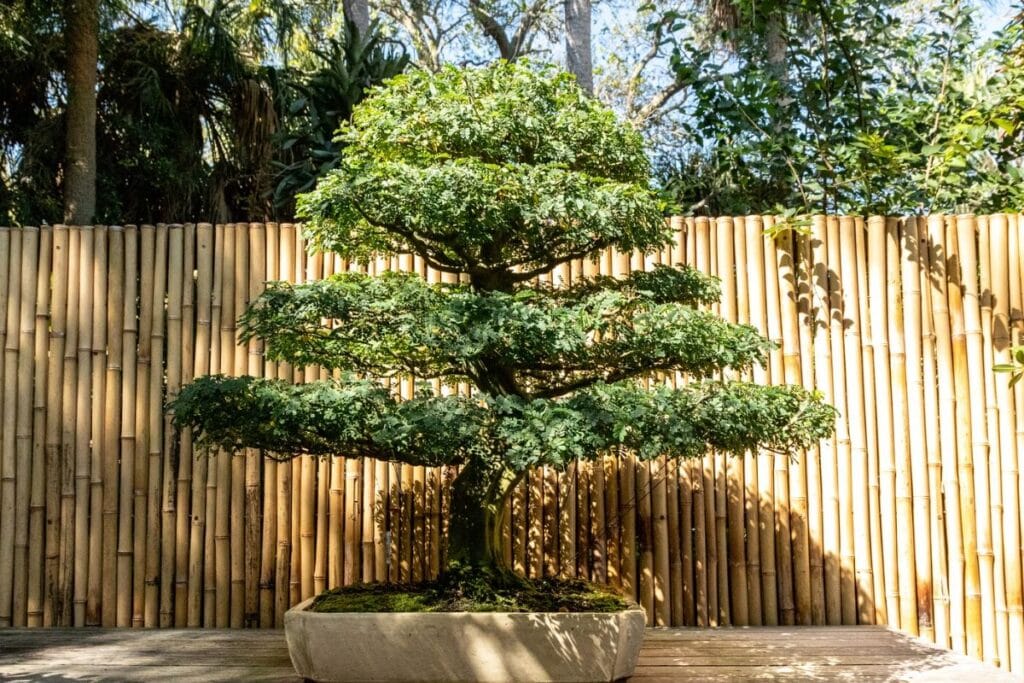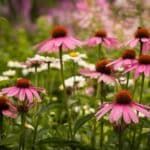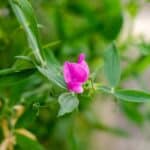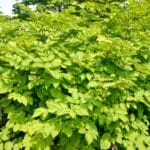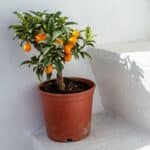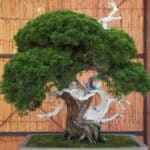Native to Brazil’s most beautiful rainforests, the Brazilian Rain Tree bonsai is a hardwood bonsai specimen worth your consideration. This plant has delicate branches and elegant compound leaves that furl together in the evening before opening up in the morning.
It produces gorgeous white or pink flowers, each of which releases a tantalizing aroma. Along with species like the Powder Puff, Tamarind, and Acacia tree, this plant belongs to the Leguminosae family.
While it can be grown outdoors, it is one of the best bonsai species you can grow because it is well-adapted to being grown in a container, too.
Interesting Facts about Brazilian Rain Tree Bonsai
Height: 14 inches
Width: 10 inches
Sunlight: Full sunlight
Flowering Time Length: Daily
Lifespan: 100+ years
Scientific name: Pithecellobium tortum
Types of Pithecellobium Tortum
Although there’s really only one kind of Brazilian Rain Tree plant, there are several others that are closely related to this tree that do well when grown as a bonsai subject. In fact, there are more than 12,000 species in the legume family with the Brazilian Rain Tree bonsai.
Growing Brazilian Raintree Bonsai from Seed or By Propagation
Brazilian Rain Tree bonsai can be grown from seeds and cuttings. You can also grow this plant through the process of air-layering.
How To Care for Brazilian Rain Tree Bonsai
Sunlight
The Brazilian Rain Tree bonsai must be exposed to the full sun, like its natural habitat, if grown as an indoor plant.
The ideal location will be a sunny position that does not experience temperatures lower than 45 degrees Fahrenheit. If it gets colder than this, the bonsai tree needs to be taken indoors and placed in a window that receives good southern exposure.
However, on the hottest days of tropical summers, you should shade your bonsai tree to prevent it from scorching.
Watering
You should never allow the root ball of the Brazilian Rain Tree bonsai to dry out completely. This plant likes to be kept moist!
When growing this plant indoors, put the plant on a tray with some wet gravel or spritz it on a regular basis with a spray bottle. This will allow this hardwood tree to stay moist without leading to problems with root rot.
Fertilizing
You can use a balanced liquid fertilizer to feed this tree, ideally once per week during the growing season and once a month during the winter dormancy.
Potting and Repotting
Your Brazilian Rain Tree bonsai will need to be repotted once every two or three years. When you do this, prune the root system and transplant your tree into a well-draining soil mix. This will help the tree avoid root rot.
Pruning a Brazilian Rain Tree Bonsai
Pruning a Brazilian Rain Tree bonsai involves selective trimming to maintain its desired shape and size. Use sharp, clean bonsai pruning shears to remove unwanted branches, shoots, or leaves.
Focus on areas with dense growth to enhance the tree’s structure, promoting air circulation and sunlight penetration. Regularly prune during the growing season, typically in spring or early summer, when the tree is most vigorous.
Additionally, it is important to perform moderate root pruning when repotting to ensure that the tree’s roots are healthy and well-maintained.
Pay attention to maintaining a balanced silhouette, removing dead or weak growth, and shaping the branches to achieve a harmonious and aesthetically pleasing appearance for this tropical bonsai species.
Pests and Diseases
Resistant to most diseases and pests, you likely won’t find any issue with your plant unless poor conditions weaken it. It can occasionally be attacked by nematodes, which create visible root nodules that then become integrated within the roots. If this happens, you can use a nematicide.
Some other pests occasionally bother the Brazilian Rain Tree bonsai, too, including spider mites, aphids, and whitefly. Again, these can be controlled by ensuring proper fresh soil conditions and using various pesticides to control their spread.
Where to Buy Brazilian Rain Tree Bonsai
You can purchase Brazilian Rain Tree bonsai trees at most garden centers and from specialized nurseries.
In most cases, buying from a retailer that specializes in bonsai is recommended, so you’ll receive a plant that is best-suited for container growing.
FAQs
What temperature is good for Brazilian Raintree bonsai?
Brazilian Raintree bonsai prefers temperatures between 60-75°F (15-24°C) but can tolerate slightly higher or lower temperatures. Protect it from frost and extreme temperature fluctuations.
Do Brazilian rain trees lose their leaves?
Yes, Brazilian Raintree bonsai is deciduous, meaning it does lose its leaves seasonally, usually in late winter or early spring. It is a normal part of its growth cycle.
Why is my Brazilian rain tree turning yellow?
Yellowing leaves on a Brazilian Raintree bonsai could be due to various factors, including overwatering, underwatering, poor soil drainage, or pest infestations. Evaluate its care routine, adjust watering practices, and inspect for pests to address the issue.
*Photo by [email protected]/depositphotos

